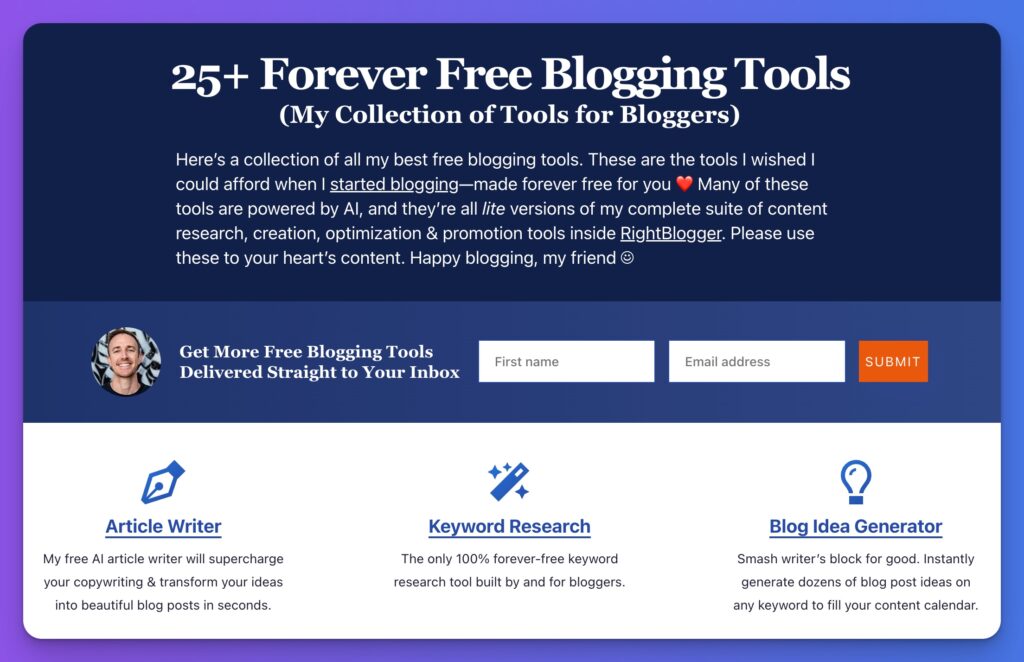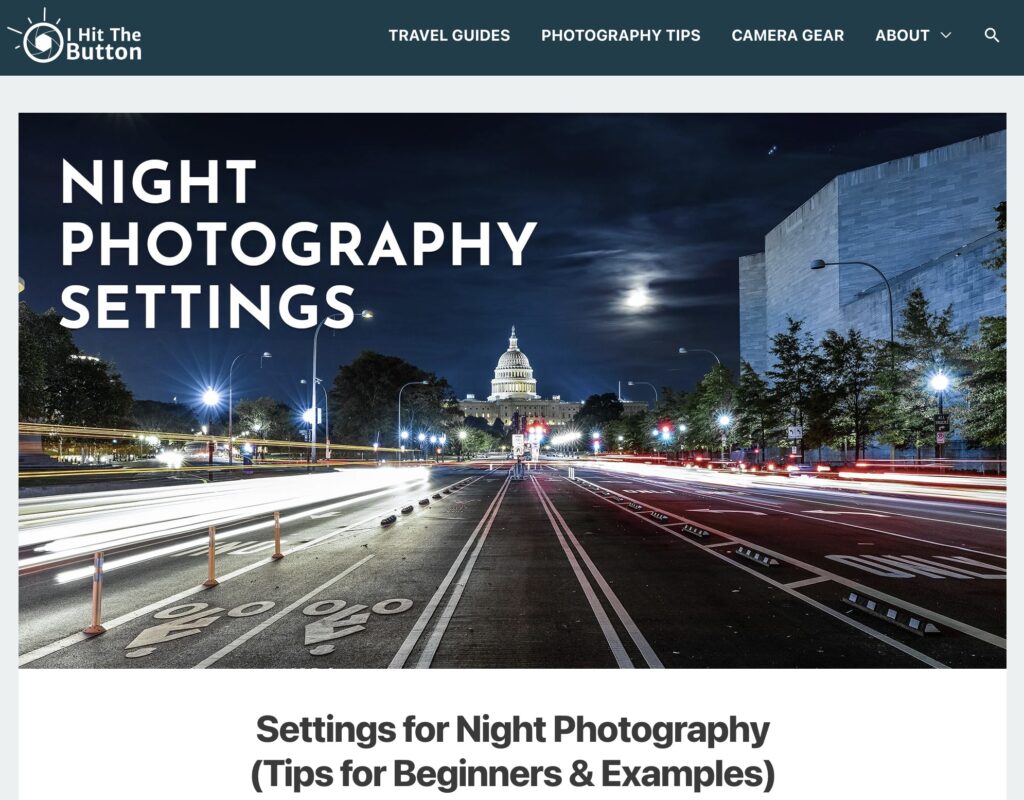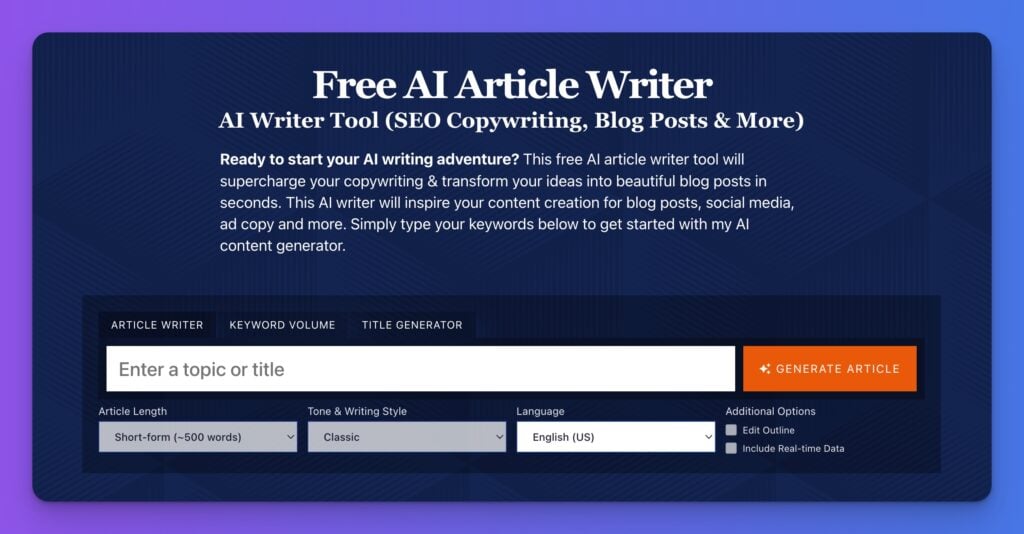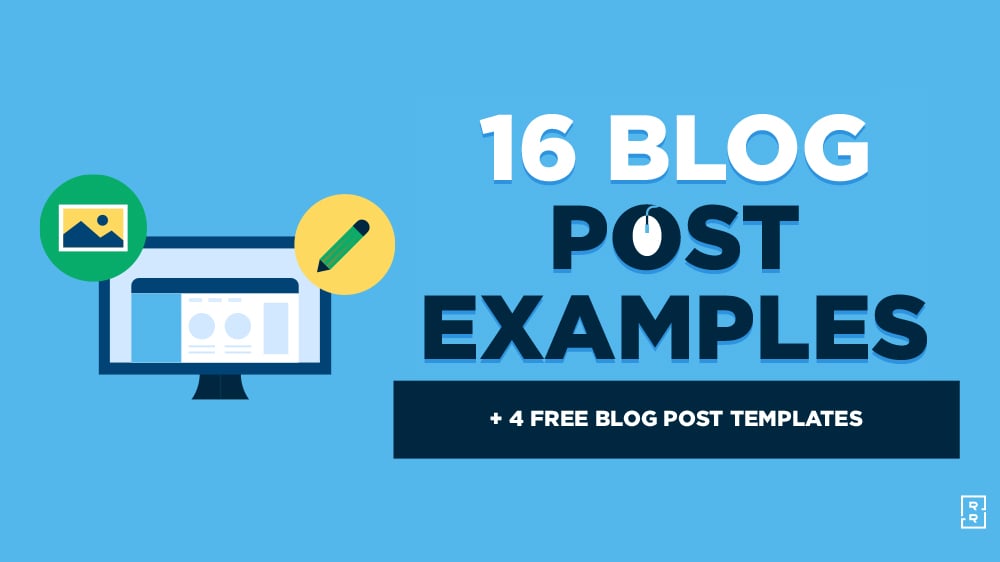Your blog’s success is completely dependent upon the quality of your posts. Low quality blog posts? Don’t expect readers.
If you’re going to start a blog, attract readers—and keep them coming back for more—then your blog posts need to be engaging, interesting, accurate, and well-written.
This can be a real challenge when you’re starting out as a blogger. Trust me, I knoooooow. Just finding the time to write blog content can be tough, but you may also struggle to know what to write about or how to put your posts together. For those challenges, you can use my free blog idea generator.
I’m going to run through lots of great examples of excellent blog posts so you can learn from some of the best bloggers out there. I’ve picked a range of different types of posts from lots of different blogging niches to help inspire you and to show you the range of styles and blog post structures that you can use. Watch my video teardown of these blog post examples, right here:
First, let’s take a look at the absolute basics: the things that every blog post needs to have.
17 Blog Post Examples (to Write Better Blog Posts) + 4 Free Blog Post Templates
Disclosure: Please note that some of the links below are affiliate links and at no additional cost to you, I’ll earn a commission. Know that I only recommend products and services I’ve personally used and stand behind. When you use one of my affiliate links, the company compensates me, which helps me run this blog and keep my in-depth content free of charge for readers (like you).
Use My 25+ Powerful Free Blogging Tools Today


When I first started blogging, I couldn’t afford fancy tools. That sucked. And that’s why I’ve built a stable of powerful free blogging tools ranging from keyword research to an AI article writer, blog idea generator and more. Forever free for all to use—no strings attached.
4 Essential Ingredients for Every Blog Post
Whatever type of blog post you’re writing, whoever your target audience is, and whatever niche you’re working in, you’ll need these four key elements:
- Title: Your blog post title needs to be clear—not clever. Don’t try to get too artful when coming up with a blog title, use my free blog title generator instead. You want readers to know what to expect from your post. Plus, you want to use keywords in your title for SEO (search engine optimization) purposes.
- Introduction: Your post introduction should set the scene for your article. It needs to grab the reader’s attention and it also needs to make it clear that they’re in the right place for the information (or entertainment) they’re seeking.
- Main body: Your post’s main body is the meat of your content. It needs to be structured so that your reader doesn’t feel lost part-way through and it also needs to deliver on the promise of your title and introduction. Your main body may well take up 80% or more of your post’s word count.
- Conclusion: Finally, your conclusion needs to draw your post to a close. You might recap your main point, share key takeaways, or end on a positive, encouraging note. You can also use the conclusion to add a call to action, encouraging the reader to check out a product, read another post, leave a comment, or anything else that you’d like them to do next.
Clear on all these key elements of a successful blog post? Then let’s dig into some examples of blog posts that can help you with your content marketing. I’ve picked a range of different types of content covering all sorts of different blog topics. And be sure to check out my free AI article writer if you want to see what it’s like to generate first drafts of blog posts using AI.
Want my Free SEO-Driven Blog Post Template?
Grab my free template to create your own traffic-driving content today.
“*” indicates required fields
17 Blog Post Examples to Learn From in Different Niches (and Why They Work)
First up, we’ll take a look at some small business blog post examples—one of my favorite blog niches.
Small Business Blog Post Examples
First up, an example blog post from yours truly!
Example 1. “How To” Post: Guest Blogging 101: How to Guest Blog Post (RyRob)


The “How To” post is a classic and straightforward structure. It’s a great fit for giving small business or startup advice—there are a lot of things that entrepreneurs will need to know how to do! It’s also a fantastic format to use in any niche if you’re trying to build a successful blog, as educational content is hugely popular online. You’ll find how to posts on blogs ranging from travel to parenting to crafts to DIY.
In this example, you can see that I’ve broken the process into numbered steps, covering everything from knowing if you’re ready to guest post to pitching and writing your post to getting even more from your guest blogging efforts.
Tip: Check out the table of contents for the post near the top, which lets readers jump straight to different steps. This is a great blog feature to include for “how to” posts that might take readers a while to implement—it helps them come back to your post again and again, picking up where they left off.
Example 2. Mistakes to Avoid Post: 7 AI Content Creation Mistakes to Avoid (RightBlogger)


I’ve been honing my AI blogging process for a while myself now. Add to that everything I’ve learned from the thousands of customers using RightBlogger, I’ve really been able to break down the right (and wrong) ways to leverage generative AI, ChatGPT and it’s alternatives, for content creation today.
This post and video I made for the RightBlogger blog serves as an in-depth guide to avoiding the most common pitfalls that’ll take these potentially powerful AI tools, and turn them into more of a hindrance than help.
From developing an over-reliance on AI, to bulk publishing, not spending enough time editing your AI first drafts, poor prompting, and more—I really spell these mistakes out clearly. And this video adds a lot of color to the subject at hand:
Tip: People love learning from experts in their field—that’s one of the primary reasons you’ll attract (and retain) readers on your blog over time. Sharing openly, honestly, about the mistakes you’ve made along the way to building your expertise within your niche, is a great way to not only deliver real value to the people who come to your content, but to also build lasting, meaningful connection with them. This type of blog post example builds closeness with readers quicker than most other formats.
Example 3. “What Is” or “What Are” Post: What Are Topic Clusters? Do You Need Them? (with Video) (Clearscope)


Definition posts that explain a term are great for increasing your traffic from search engines, as plenty of people will be searching for keywords like “what is…” or “what are…” They’re also a useful way to show your expertise in your niche, as they let you give a clear and comprehensive explanation of an important term.
In this example, Travis Dailey breaks the post into a number of different sections, explaining not just what topic clusters are but why they’re important for SEO, before going into “how to” style details on using topic clusters. If you’re writing a similar post, make sure you include the “why” and “how” as well as the “what” and your post will be an example of quality content.
Tip: Travis uses a number of images in the post to help explain the concept of topic clusters more fully. Diagrams, screenshots, and other visuals can be a great way to convey information to your reader and they’re particularly well-suited for this type of post.
Example 4. Question from a Reader Post: Mailbag Monday: “It’s all been done before.” (IttyBiz)


If you already have an established audience, taking questions from readers can be a great way to write posts that you know at least one reader will love! If someone has written to you with a question, there’s a good chance that plenty of your other readers are having the same problem or wondering about the same thing.
In this example, Naomi Dunford answers a common question in the small business world: “What do I do when it’s all been done before?” As is typical with reader question posts, the post starts off with the full text of the question itself (in italics here to help set it off from Naomi’s response) and then Naomi gives her response, offering a couple of allegories to help the reader see things in a different—and more positive—way.
Tip: In a reader question post, it might be tempting to think that structure and formatting don’t matter much. But note how Naomi has used subheaders (and short paragraphs) in this post to keep it tightly structured, and how she has a conclusion at the end. It’s not just a rambling response like an email might be: it’s a blog post.
Photography Blog Post Examples
Example 5. “In-Depth Tutorial” Post: Night Photography Settings (I Hit the Button)


I’m a sucker for in-depth tutorial-style content, and this blog post example by my friend, Andy Feliciotti, on his photography blog, I Hit the Button, knocks it out of the park with a shocking level of detail.
Sharing hyper in-depth tutorials is a fantastic way to build meaningful relationships with your audience, based on delivering insane up-front value. This blog post excels in many ways, including a major boost from Andy’s actionable step-by-step video embedded right near the top of the post, giving readers the opportunity to visually follow along with his night photography settings.
Tip: Be open, honest, and real when teaching tutorials to your audience. Don’t seek to teach something you don’t actually know well, yourself (yet). If you need to research, that’s ok—but really invest time and effort into your skills & experience, so that you’re teaching readers and viewers from a place of authority and lived experience. Andy’s post works so well, because he’s a pro-level photographer that’s been honing his craft for well over a decade. He’s the kind of teacher a new night photography enthusiast wants to learn from, and when readers dive deeper into his content, they’ll see more value-packed stuff like his location guide to Washington DC’s best Instagram spots.
Example 6. “X Ideas” Post: 6 Ideas for Stunning City Photography (Digital Photography School)


The “ideas” post is a highly popular blog post format—for good reason. It’s a straightforward type of post to create, it can work for every niche out there, and it’s also an easy and fun style of post to read. The key difference between an “ideas” post and a “how to” post is that the reader can pick and choose from an “ideas” post—they don’t need to do all the items on the list and they also don’t need to do them in order.
In this example, Jeremy Flint runs through a series of ideas for city photography, including skyscrapers, nighttime shots, reflections, aerial shots, and more. The post is structured in a straightforward way, with a numbered subheading for each idea.
Tip: As this is a photography blog, it makes a lot of sense that Jeremy has included a photo straight after each subheading, to illustrate each idea. But you could also use this for any other type of blog. Including images throughout your post can help break it up and make it more visually interesting. You definitely don’t need to be an expert in web design to do this: just follow my handy guide to adding images on your WordPress blog.
Example 7. Review Post: Beautiful and Versatile! Fujifilm GF 20-35MM F4 Lens Review (The Phoblographer)


Review posts are a fantastic way to monetize your blog through affiliate marketing. Your regular readers are likely to at least check them out—but their real power comes from search engine traffic. Lots of consumers will search for a product name plus “review” before deciding whether or not to make a purchase, and detailed review posts let you capture this traffic.
In this example, Brittany Smith gives a detailed review of the Fujifilm GF 20-35mm f4 WR lens. She starts off with “The Big Picture”, giving an overview of the lens, then digs into pros, cons, and offers detailed photos of the lens itself as well as a wide range of photos taken using the lens.
Tip: Like Brittany, you should be honest in your reviews about any downsides to the product (or service) you’re reviewing. For instance, Brittany points out that the lens was quite slow to focus, especially when close to the subject or in backlit situations. Being honest about the drawbacks to a product (a) protects your readers from buying something that might not be suitable for their situation and (b) helps establish your credibility as a reviewer.
Travel Blog Post Examples
Example 8. “X Best” Post: 16 Best Hiking Books to Read (Books About Hiking) (Hike With Ryan)


Lists of the best products, resources, books, or anything else in a particular category are fun to put together, useful for readers, and great opportunities for affiliate income, whatever your niche. There’s also a good chance that the creators (e.g. authors, companies) mentioned in your post may well be willing to share it on social media or even link to it, helping to bring more traffic to your blog.
In this example, I run through 16 of my favorite hiking books, explaining what each book covers and what I love about each one. As with any list post, I’ve structured this with numbered subheadings. Because the books cover a range of topics (and this is a fairly long post), I’ve also included subheadings like “Best Hiking Books to Equip You to Be a Better Hiker” and “Best Hiking Books to Entertain You” to make the list easier to navigate.
Tip: Notice how each section of the post starts with a short paragraph introducing the book, then a photo of the cover? That’s no accident: I deliberately crafted this post to make the structure consistent. This might seem like a small thing—but it’s an example of blog writing that sets and meets readers’ expectations.
Example 9. “X Things to Do” Post: 59 Best Things to Do in NYC on a Rainy Day (By a Local!) (Jessie On A Journey)


Similar to a “best of” list of products or services, a “things to do” post is the perfect fit for travel blogs and for local blogs that cover a particular area. You could also easily use this type of post for a parenting blog, lifestyle blog, health blog, fashion blog, and more. By bringing together a list of local attractions—both the well-known and hidden secrets—you’ve created a great resource for your readers. Like review posts, these types of posts can be great for search engine traffic too.
In this example, Jessie Festa has come up with a twist on run-of-the-mill “things to do” posts by listing things to do on a rainy day. One neat thing to notice in the way she’s written this post is how each subheading starts with a verb: a great way to be consistent when creating a list of items, and also a way to emphasize doing things.
Tip: “Things to Do” posts are another good opportunity to use affiliate links: while smaller local attractions may not have affiliate programs, local hotels and tours might well do. You can see how Jessie has included a list of hotels toward the end of the post.
Food Blog Post Examples
Example 10. Recipe Post: Black Bean Sweet Potato Chili (What’s Gaby Cooking)


Recipe posts make up a huge part of most food blogs, though they’re also a type of post you might consider in some other niches like parenting, health & fitness, and lifestyle. Obviously, a big part of a recipe post is the actual recipe itself—but you’ll also want to include an introduction to it plus things like links and ingredient substitution tips.
In this example, Gaby starts off the post with a powerful and compelling introduction, beginning with the line, “This smoky Black Bean Sweet Potato Chili is going to rock your world!” It’s a great way to draw the reader into the recipe, especially as she also says that the chili “will convert any meat lover.”
Tip: Gaby includes lots of details about the recipe, like prep time, cooking time, servings, and nutritional information. You don’t necessarily need to include all of this in a recipe post—but the more useful facts you can add, the easier the recipe will be for readers to use.
Example 11. “Where To” Post: Where to Eat and Drink in Boston: A Local’s Guide (Serious Eats)


A great fit for both travel bloggers and food bloggers, “where to” posts let you bring together the best places to eat in a particular location. You can show off your detailed local knowledge, build relationships with local restaurants and eateries, and get readers salivating over your wonderful descriptions of favorite dishes.
In this example, Amy Traverso shares lots of tips that are clearly borne of extensive experience. For instance, when writing about the restaurant Picco and its owner Rick Katz, she says, “In all the years I’ve been eating his pies, I’ve never once found a soggy center or less-than-open crumb or inadequate rise around the sides.” Including this type of personal detail helps her post to stand out as much more than just a list of restaurants.
Tip: While it’s unconventional to jump straight into the first list item without any introduction, there’s an introduction-of-sorts in the first line of the first item: “Of course there’s a lobster roll on this list–and to start things off, no less. Without eating one, you could hardly say you’d been to Boston.”
Self-Improvement Blog Post Examples
Example 12. “Why” Post: Why Every Small Business Needs a Strategic Plan (and How to Create One) (Michael Hyatt)


The “why” post can work in pretty much any niche, but it’s a particularly great fit for blogs about self-improvement, personal development, leadership, and other topics that prompt introspection. In this type of post, you’re making the case for why something is important or why it works so well. It usually also makes sense to start readers off with the how of doing something, once you’ve convinced them that it’s worth doing.
In this example, Michael Hyatt defines what exactly a strategic plan is, and explains why it’s important to small businesses, going through three key benefits before getting into some quick tips on how to create a strategic plan. He also offers advice on how to get help—neatly segueing into a short pitch for his on-demand Strategic Design Workshop.
Tip: Michael often starts his posts with a personal example or anecdote: this helps establish his credibility and experience with what he’s writing about. Here, he shares the problems caused by having “no vision or plan” and explains that “once we created a strategic plan and executed it, we turned things around in 18 months.”
Example 13. “How I” Post: How I’m Easing Into the New Year (The Blissful Mind)


“How I” posts can help you establish a stronger connection with your reader by sharing something that you are doing. You might share a case study or success story, or you could talk about something that went wrong for you (like I did when talking about my early failed product, the iStash). “How I” posts can also give you the opportunity to share “how to” style content in a more personal way. You can use them for almost any type of blog, particularly if you’re talking about a personal journey—e.g. on a fitness blog.
In this example, Catherine Beard takes a different angle on new years’ resolutions and success, explaining how she’s taking a slower and more gentle approach, and explaining how she’s chosen specific anchor words for the year (pursue, presence, and connect).
Tip: Catherine ends the post with “How are you easing into the new year?” Asking a question at the end is a great way to open up the conversation and invite readers to leave a response.
Lifestyle Blog Post Examples
Example 14. “Things I Love” Post: 10 Things I Love Sunday (A Beautiful Mess)


Sharing a list of things you love can be an easy way to produce content for any kind of personal blog or lifestyle blog, from personal development blogs to interior design blogs. It helps you connect to your readers, lets you make product recommendations in a low-key way, and it’s also a type of post that doesn’t take much planning or research.
In this example, Emma Chapman shares 10 things she’s been enjoying during the previous week. It’s a casually-written post, in keeping with her usual blogging style: there aren’t subheadings, just a simple and short numbered list.
Tip: Emma finishes off this post with some links to other recent posts: a useful technique to use if you’re publishing a weekly roundup or weekly themed post like this one. Your reader will be deciding what to do next after reading your post—so make it easy for them to stick around on your blog by giving them some options!
Example 15. Question Post: What’s the Most Helpful Thing a Therapist Has Ever Told You? (Cup of Jo)


This type of question post is the flip side of a “question from a reader” post. Instead of taking a reader’s question and answering it, you’re posing a question for your reader to answer. It’s a great fit for any bloggers who have an interactive and perhaps fairly informal blogging style, and works particularly well for lifestyle bloggers and personal bloggers.
In this example, Joanna Goddard is asking her readers to share the most helpful thing a therapist has ever told them. She introduces the topic by talking about the most helpful thing she heard from her therapist (“both things can be true”) and runs through some examples of this in her own life. Then, she opens up the post for readers to respond—and she has over 900 comments.
Tip: You could take this format even further by selecting some of the best reader responses to use in a future roundup post—make sure you credit people and link to their original comment (or their blog/website).
Personal Blog Post Examples
Example 16. Challenge Post: Ready for the Tranquility by Tuesday Challenge? (Laura Vanderkam)


A challenge post can be a great way to bring together your blogging community. It’s a good fit not just for personal blogs but also lifestyle, small business, and hobby blogs (e.g. photography blogs often run photo challenges). You’ll need to publish a post that introduces the challenge and explains how it works and you may also want to publish posts during and after the challenge to share your progress and readers’ progress.
In this example, Laura Vanderkam explains a new challenge she’s running, based on her recent book Tranquility by Tuesday. It’s a short, straightforward post that explains how the challenge will work and Laura includes a link to sign up for the challenge emails.
Tip: Make your challenge straightforward to participate in. With Laura’s challenge, all readers need to do is enter their email address to get started. If you’re going to be sending emails, be clear about what people are committing to: Laura explains “people who sign up for the challenge will get two emails per week for nine weeks”.
Example 17. Lessons Learned Post: Lucky 13: A Baker’s Dozen of Unexpected Parenting Lessons (Designer Daddy)


If you’ve been writing in your niche for a while, you’re sure to have plenty of “lessons learned”—things that you’ve discovered along the way, possibly through trial and error or through making mistakes. Sharing these lessons with your readers, probably in a list post format, can be a good way to offer lots of disparate pieces of advice that might not be worth a full post in themselves.
In this example, Brent Almond shares what he’s learned on his journey as a parent with a now-13-year-old. The post includes colorful subheadings (matching Brent’s usual style) and is full of insights and little personal snippets, in a chatty way with lines like, “Yeah, we let our son watch horror movies; no, we’re not worried he’s going to become an ax murderer.”
Tip: Don’t be afraid to talk about the things you’ve struggled with—this can help readers to know that they’re not alone and it can also help them to feel a greater sense of connection with you. Brent talks about his worries and shares struggles, like “I often don’t know the right thing to say — or the right way to say it.”
Bonus Blog Post Examples
Want more blog post examples? Here are some extra pieces of great blog content to check out:
4 Simple Templates You Can Use to Write Your Own Fantastic Blog Posts
When it comes to putting together your own post, the easiest way to nail a great structure is to start with a template.
Here are 4 really simple templates pulled straight from my downloadable blog post templates you can use for 4 very popular types of posts.
Want my Free SEO-Driven Blog Post Template?
Grab my free template to create your own traffic-driving content today.
“*” indicates required fields
1. How To Blog Post Template
Introduction, explaining what the reader is going to learn or accomplish.
Step 1. [First Step] (subheading)
Explain how to carry out the first step, potentially with images
Step 2. [Second Step] (subheading)
Explain how to carry out the first step, potentially with images
… and so on.
Conclusion, recapping what the reader should now have achieved.
2. Listicle Blog Post Template
Introduction, hooking the reader and setting the scene for the post.
- Subheading
- Subheading
- Subheading
… and so on.
Conclusion, perhaps picking out one or two easy items to try, or encouraging the reader to share their own ideas in the comments.
3. Why & How Blog Post Template
Introduction, briefly explaining the concept
Why You Should Do X (subheading)
How to Do X (subheading)
- [First step]
- [Second step]
- [Third step]
…and so on
Conclusion, summing up why X matters and encouraging the reader to take the first step to get started.
4. Review Blog Post Template
Introduction, clearly stating what product/service you’re reviewing.
Overview (subheading)
—in this section, include basic details like the price, what it does, etc
What I Liked (subheading)
What I Didn’t Like (subheading)
Verdict (subheading)
— this is the conclusion, explaining if the reader should buy it / who it’s suited for
Note: You can change the subheadings to suit you. You might want to keep them consistent across different review posts on your blog.
For more detailed templates, plus lots of extra templates, check out my 10 Blog Post Templates. This free download includes the following:
- How to Post Template
- Beginner’s Guide Template
- List or “Listicle” Post Template
- Expert Roundup Post Template
- Glossary Post Template
- Case Study Post Template
- A vs B Post Template
- Myth Buster Post Template
- Product Review Post Template
- Infographic Post Template
- BONUS: SEO-Driven Template
Use These Inspiring Blog Post Examples to Write Great Posts of Your Own
Your blog post doesn’t need to be incredibly in-depth or formally written to be effective. Plenty of the blog post examples above are short, and a good number of them have an informal style. You could write a short, well-structured, and useful post that makes a powerful impact.
What matters is that you spend some time putting together a post that makes an effective point or shares a range of useful ideas with your readers. Write your posts in a way that feels natural and comfortable to you—using your own voice—and you’ll soon start to build connections with your audience.
If you’re working on some blog post ideas or taking a look through examples while waiting to get your blog up and running, then it’s time to get going! My step-by-step tutorial on starting your own blog will help you have your brand new blog ready for all your posts in just 10–15 minutes.
Use My Free AI Article Writer Tool


Try my free AI-Powered AI Writer Tool to write free SEO-friendly blog posts in the click of a button.
Publisher: Source link











